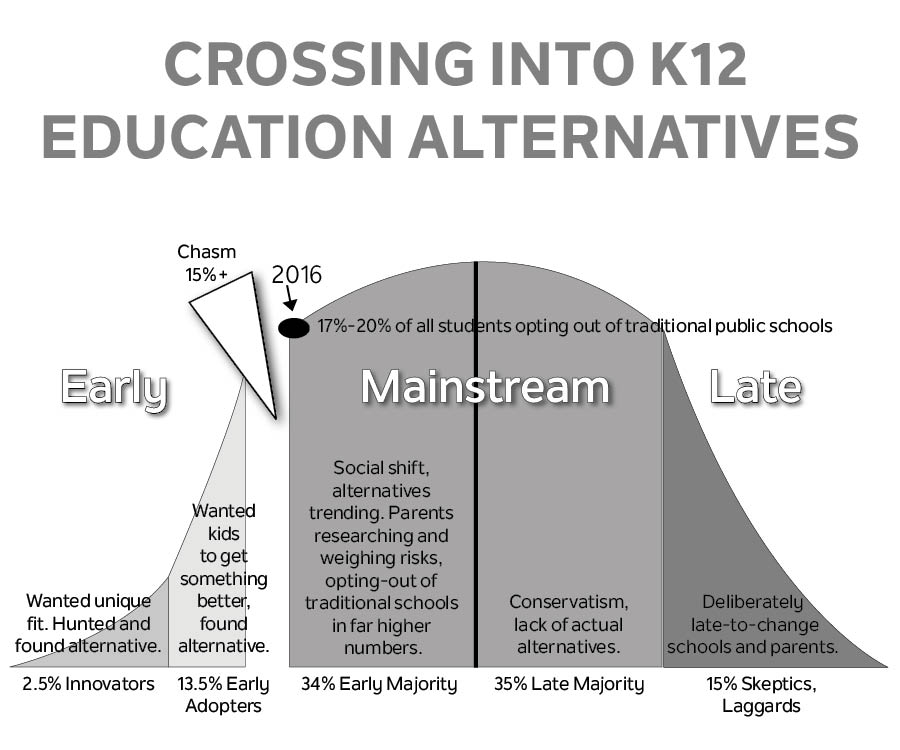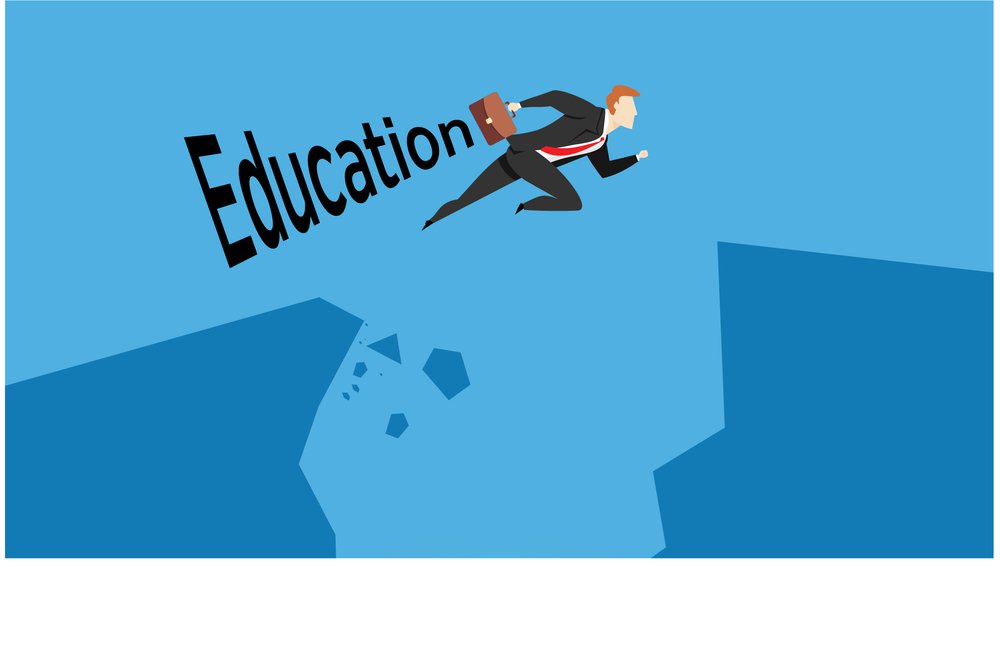The education market is crossing into the digital reality that other markets, like manufacturing, insurance, and retail have already crossed. Typically, there are millions of small efforts by individuals to gain sufficient momentum to carry an initiative or company, or in this case, a whole market like education, out of the wading pool of novelty start-ups into the big leagues. With the dramatic influx of tablet computers in the last several years, loads of educators nationwide started this journey, carrying all of the sector with them into a digital transition.
What’s interesting is that once a market reaches a certain amount of momentum, typically at around a 15% adoption, widespread change can be seen to happen. It starts to be noticeable, with more “buzz.” It’s a sort of magic point.
The 1991 book Crossing the Chasm by Geoffrey A. Moore argued that there is a gap that exists between the early adopters of any technology and the mass market because typically the masses are more conservative. He explained that many technologies initially get pulled into the market by enthusiasts, but later fail to get wider adoption because of this inherent market inertia. Institutions and markets tend to hold their own form resolutely, decrying change in service to what they know or have known of structure. It has worked.
The education sector is famous for having lots of enthusiastic “one-offs,” or teachers who stand out from the rest in their tech and app use. School administrators often wonder how in the world they can get “everybody else,” meaning all the rest of the teachers in their school, to be the same.
Getting uniform adoption and competency by users is the bane of all technology adoption, in every sector. There is evidently not just a chasm to cross for markets, but for individuals. Some cross it more easily than others. Some run to it, while others hold the form of their own structure, especially if it has worked for them in the past.
The “chasm” is typified by a sort of bell-curve showing that after technology enters the scene, about 2% are the early “Innovators.” Culturally, we have been known to call these the “lunatic fringe” when talking politics or social anomalies. In education, they are a more interesting rare type – those who find, figure out, and alter their teaching practice to give their students something entirely different than what was done before. They are minor miracle workers and those that buck the norm.
The next group is the “Early Adopters.” These constitute another 13% plus the original 2% for a total of 15%. In education, these are the teachers who are willful about their teaching, who may not be the first to try new tech but are always on the prowl for things that work to better learning.
As soon as someone else legitimizes it, they are behind it, and soon. What’s interesting is that in the U.S. today, we have exceeded the 15% norm for alternative educational paradigms already. The chasm is between this 15% and the “Early Majority” or next 34% leading up to the top of the bell curve. This “Mainstream” group is the hard part. This is where we work to get every other teacher remaining to be fully digital and have new levels of administrative change to facilitate a change across the board. It requires determination by leaders to lead through change, to gain, themselves, the mindset of the “Innovators” at the beginning of the curve where running entirely on technology has never been done before. It’s a changed viewpoint.
It’s likely that we are in the stage now of “crossing the chasm” as a society with education into a new digital reality. This is because, once past the early adopters and the early majority begin to transition to new technology or adopt change, then there is a certain momentum that creates inevitability for every other part of the market.
There is a potential that learning consumerization is the bridge across the chasm for education, to a place where the majority has adopted alternatives to traditional institutional public schooling.
Right now, in the U.S., we are already at the critical tipping point of children in the K-12 Education sector in various flavors of alternatives to traditional public education. The alternatives to the historically typical school in the public system reached 17% in 2012 according to the data sets of National Center for Education Statistics (NCES 2013 study) depicting which types of schooling environments have what numbers of the total student body in K12. Granted a large part of this was still public, just moved over into charter schools or “School Choice.”
What’s remarkable is that when this data is updated through 2017, it will probably show a much higher percentage have moved to alternatives since the charter schools and unschooling movement are stating record growth numbers.
Based on that data, the alternative shift is at least at 20%, and indications are that it will continue to be pushed politically. These are also indicators that the technically sophisticated among us have allied with the monied interests to take advantage of the potentials of digital learning, particularly items with consumer-like distributions.
I consider this means learning consumerization has more than a small chance of structural significance in the future of learning distribution. The change will not be like a tsunami, despite these numbers indicating a fairly fast-moving crossing for this last great market, education.
Tools for sharing information, working systems, new best-practices, digital lessons, and complete district-wide digital curriculum inventories (and making them accessible to all instructors) are going to become critical. This is why I’ve focused much Learning Counsel energy to building KnowStory as a free sharing platform for all of education. Its only because I found no other solution like it that it exists.
Schools still have time. Building high-value digital curriculum software is not as simple as an animated game. Rigorous materials packaged together into flawless experiential learning take a lot of money and time. We will see a gradual evolution that will come to be seen as more like the fast-moving and wide gulfstream – teeming with life and possibility.










